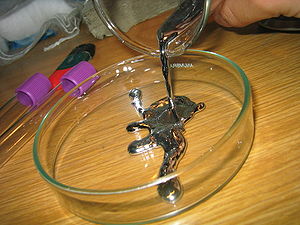Complete question: what are the conditions for solubility in water, and is CH3NHCH3 soluble in water?
Hence, metals dissolve in metals, polar compounds dissolve in polar solvents, non-polar compounds dissolve in non-polar solvents, hydrogen-bond-containing compounds dissolve in hydrogen-bond-containing solvents, and so forth. For example: common table salt (NaCl), which is an ionic/polar compound, dissolves in water, which is polar, but not in cooking oil, a non-polar compound. On the other hand, other types of oil are soluble in cooking oil, but water isn't.

In the process of producing aluminum, aluminum oxide (Al2O3, an ionic compound) is dissolved in molten cryolite (Na3AlF6, another ionic compound). Mercury, a metal that is liquid at room temperature, can dissolve copper and gold, other types of metals.

Mercury (adopted from Wikipedia)
Of course things are more complicated for molecules that form different types of bonds. For example, alcohols contain a polar region that forms hydrogen bonds (-OH) and a non-polar carbon backbone. Hence, the solubility of alcohols in water is determined by the length of the non-polar carbon backbone – the longer it is, the less soluble the alcohol. Drinking alcohol (ethanol) contains a short 2-carbon atom backbone, and therefore dissolves in water at any ratio. In contrast, panthenol (also known as pro-vitamin B5, an ingredient in many shampoos), contains a 5-carbon atom backbone chain and is thus only partially soluble in water, while alcohols with a longer, 20-carbon atom backbone, are hardly water soluble at all.
You specifically asked about the solubility of methylamine (CH3NHCH3(. This is a polar molecule that doesn't comntain any long carbon chains. The nitrogen-hydrogen group allows the formation of hydrogen bonds with water, so methylamine will dissolve quite well in water.
If you find these explanations insufficiently clear or if you have further questions on this topic, please write about this in our forum, and we will relate to your comments. Your suggestions and constructive criticism are always welcome.
